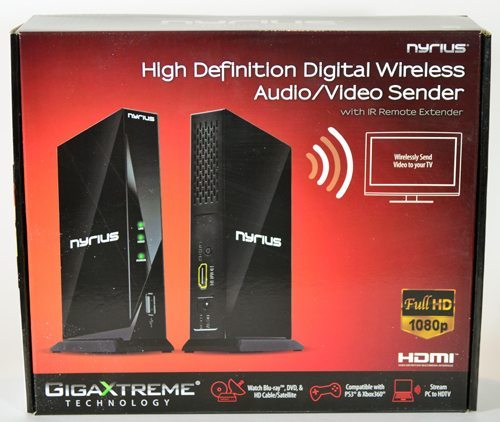 I’ve been looking for some way to occasionally watch TV on my bedroom TV without the monthly expense of a cable hookup and digital settop box in there. I’ve tried an antenna that worked great for local HD stations, and I’ve tried a wireless transmitter that worked great with my Blu-ray player but not with my cable box in the living room. Although the antenna works well, I’d still like to be able to watch recorded programs on the living room cable DVR in my bedroom. I was happy to be selected to try the HD 1080p Digital Wireless Audio Video Sender when Nyrius offered one to The Gadgeteer.
I’ve been looking for some way to occasionally watch TV on my bedroom TV without the monthly expense of a cable hookup and digital settop box in there. I’ve tried an antenna that worked great for local HD stations, and I’ve tried a wireless transmitter that worked great with my Blu-ray player but not with my cable box in the living room. Although the antenna works well, I’d still like to be able to watch recorded programs on the living room cable DVR in my bedroom. I was happy to be selected to try the HD 1080p Digital Wireless Audio Video Sender when Nyrius offered one to The Gadgeteer.
Most pictures can be clicked for an enlarged view.
Nyrius markets the HD 1080p Digital Wireless Audio Video Sender for these main uses:
- To eliminate the need for a lot of cables running to a wall-mounted flatscreen HDTV.
- In rooms where the cable box, Blu-ray player, PS3, or other HD component is located on the other side of the room from the HDTV.
- For HD components in one room of the house and the HDTV in another room (just like my situation).
HDMI cables max out at about 15 feet, and cost can be prohibitive for the longer cables. Long cables can also degrade the HD signal. You’ll also need to deal with draping long cables through your house, or you’ll need to run them through the walls or under the floors. Using the Nyrius video sender system eliminates the need for these cables, and it will broadcast “crystal clear digital sound and razor sharp 1080p video without latency.”
- Digital wireless HD transmitter
- External IR remote extender
- Digital wireless HD Receiver with built-in IR remote extender
- 2 100-240V AC power adapters
- 6-ft HDMI cable
- Stands for supporting the boxes in vertical orientation
- Instruction manual
- 1-year warranty and lifetime live customer support
Technical Specifications
- Supported video resolutions: 1080p, 1080i, 720p, 720i, 576p, 576i, 480p, 480i
- HDMI interface: Supports HDMI 1.3 Video Audio format and HDCP 1.2 with video encryption
- Transmission distance: 100ft (30m) Line of Sign (LOS)
- Operating frequencies: 5.1~5.9GHz (with DFS function)
- Bandwidth: 40MHz
- Frequency stability: +/- 4ppm
- Transmission power: >=12dBm | >=17dBm
- Receiving sensitivity: <=-75dBm | <=-65dBm
- System latency: < 1 ms
- Antenna: Omni-directional internal antennas
- Supporting link speeds: Up to 2.5GBps
- Compatible TV Systems: NTSC, PAL
- Certification: FCC, CE, ICES-003
- Regulations: WHDI 1.0
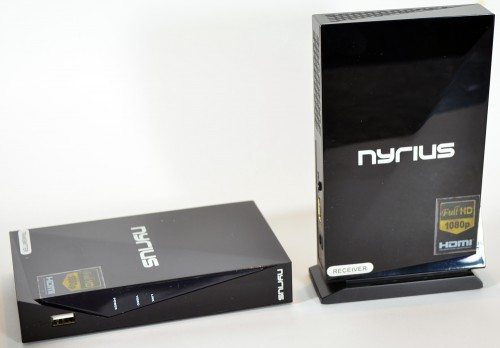 The two boxes are made of black plastic. They measure about 5.5″ X 3.5″ X 0.75″. They have rubber feet on the bottom, so they can lay flat (left), or use the included bases to stand them vertically (right). Each box is clearly marked with a white sticker to indicate which is the receiver and which is the transmitter.
The two boxes are made of black plastic. They measure about 5.5″ X 3.5″ X 0.75″. They have rubber feet on the bottom, so they can lay flat (left), or use the included bases to stand them vertically (right). Each box is clearly marked with a white sticker to indicate which is the receiver and which is the transmitter.
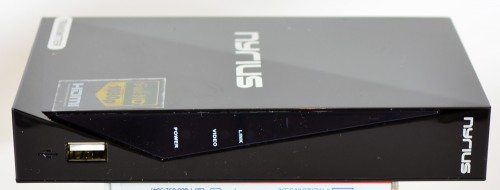 The transmitter has three green status lights on the front: link, video, and power. All three will be on and steady when a connection is established and a signal is being transmitted. The USB port is used for software updates or for attaching a keyboard or mouse. It cannot be used for attaching an external hard drive.
The transmitter has three green status lights on the front: link, video, and power. All three will be on and steady when a connection is established and a signal is being transmitted. The USB port is used for software updates or for attaching a keyboard or mouse. It cannot be used for attaching an external hard drive.
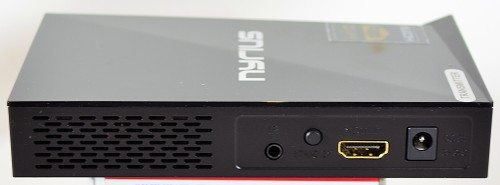 The back of the transmitter has a connector for the IR remote sensor, the standby button, HDMI socket, and the power socket. You can save about 2.5W of power by putting the unit into standby mode when it’s not in use.
The back of the transmitter has a connector for the IR remote sensor, the standby button, HDMI socket, and the power socket. You can save about 2.5W of power by putting the unit into standby mode when it’s not in use.
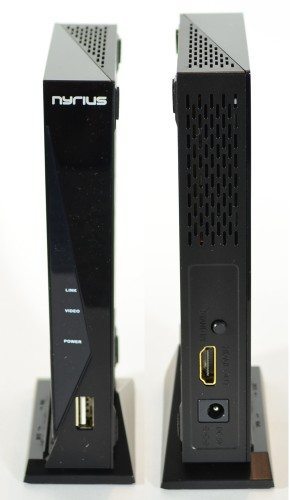 The front of the receiver has the same three green status lights as the transmitter. There’s also a USB port for software updates or attaching a USB keyboard or mouse. Not visible is a window for the built-in IR sensor located between the power light and the USB port.
The front of the receiver has the same three green status lights as the transmitter. There’s also a USB port for software updates or attaching a USB keyboard or mouse. Not visible is a window for the built-in IR sensor located between the power light and the USB port.
The back of the receiver has standby button, HDMI socket, and power socket.
I didn’t have a lot of hope that I could transmit my cable signal to the bedroom. I had tried another video transmitter system that had worked with my Blu-ray player, but it wouldn’t work with my particular cable box. That system had an internal signal splitter on the transmitter, so I could both run an HDMI cable to my living room TV and transmit the signal to my bedroom TV. My cable box detected this splitter and didn’t send a useable signal to the transmitter box; it protected its signal from being used on multiple TVs.
The Nyrius transmitter box was different than that other system’s transmitter. The Nyrius only has an HDMI input; there is no HDMI out to hook up the living room TV, too. That means I’ll have to be switching the HDMI-out from the cable box between the TV and the Nyrius transmitter if I keep using this system.
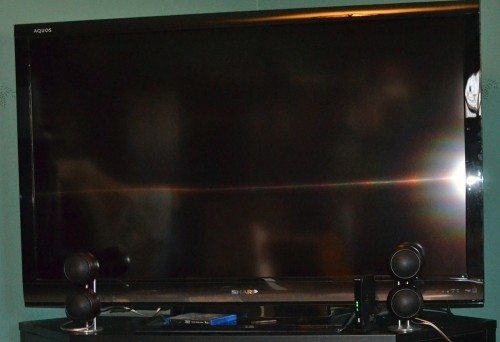 Setting up the system is easy and takes only a minute. I started in my living room. I plugged the power in to the transmitter, plugged in the IR extender and positioned it in front of the IR sensor on my cable box, then plugged in the HDMI out of my cable box into the transmitter.
Setting up the system is easy and takes only a minute. I started in my living room. I plugged the power in to the transmitter, plugged in the IR extender and positioned it in front of the IR sensor on my cable box, then plugged in the HDMI out of my cable box into the transmitter.
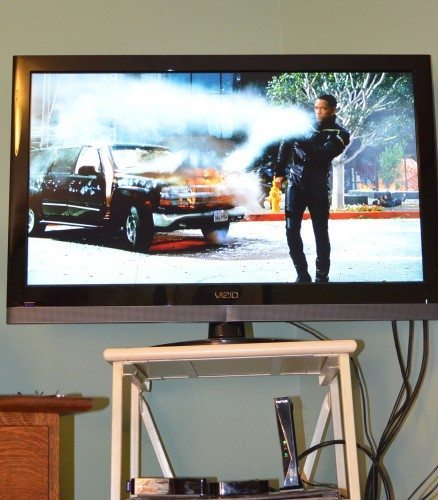 I moved to my bedroom, and plugged in the power to the receiver and connected it to an HDMI input on my HDTV.
I moved to my bedroom, and plugged in the power to the receiver and connected it to an HDMI input on my HDTV.
Lights blinked for a few seconds on both boxes, and then they finally came on steady, indicating a connection had been established between the two boxes. Instructions warn you not to move either box after the connection is made, so of course I moved one to see what happens. The lights started flashing to indicate the pairing had been broken, so I unplugged both units from the power, replugged, and established a new connection.
Once the connection was re-established, I turned on my bedroom TV and had an absolutely beautiful picture with clear sound! Obviously, my cable box doesn’t care how I send the signal to a TV so long as I send it to only one TV. I’ve watched 15 or so hours of TV on the bedroom TV now, and the Nyrius system has never faltered. I haven’t had a single jitter in the video or heard the slightest noise in the sound. The IR sensor on the receiver box in my bedroom gathers the signals from my cable box’s remote (being used in the bedroom) and sends it to the transmitter box in the living room, so I can control the cable box in the living room from the bedroom. I had placed the IR extender in front of the IR sensor on the cable box, so the remote control commands get sent from the bedroom to the cable box. There’s a tiny delay during the signal transmission, but it’s no more than I’ve experienced when using activity macros with some universal remotes.
The Nyrius video sender system works well with my Blu-ray player, too.
The Nyrius HD 1080p Digital Wireless Audio Video Sender does exactly what I need it to do. It sends the output from my cable box to my bedroom TV. I’ll be able to watch live cable programming and programs recorded by the box’s internal DVR on either my living room TV or my bedroom TV. The picture is as clear and the sound as good when transmitted to my bedroom TV as it is on my living room TV. The Nyrius HD 1080p Digital Wireless Audio Video Sender is now a permanent part of my A/V setup.
I’ll have to switch the HDMI cable from the living room TV to the Nyrius box, but that can be pretty easily done if I use the HDMI input on the side of my living room TV. Switching a cable is a small price to pay to have exactly what I want, don’t you agree?
Gerber Gear Suspension 12-in-1 EDC Multi-Plier Multitool with Pocket Knife, Needle Nose Pliers, Wire Cutters and More, Gifts for Men, Camping and Survival, Grey
$58.99 (as of December 19, 2025 17:58 GMT -05:00 - More infoProduct prices and availability are accurate as of the date/time indicated and are subject to change. Any price and availability information displayed on [relevant Amazon Site(s), as applicable] at the time of purchase will apply to the purchase of this product.)Gerber Gear Diesel Multitool Needle Nose Pliers Set, 12-in-1 EDC Multi-Tool Knife, Survival Gear and Equipment, Black
$129.99 (as of December 19, 2025 17:58 GMT -05:00 - More infoProduct prices and availability are accurate as of the date/time indicated and are subject to change. Any price and availability information displayed on [relevant Amazon Site(s), as applicable] at the time of purchase will apply to the purchase of this product.)Product Information
| Price: | $237.49 |
| Manufacturer: | Nyrius |
| Retailer: | Amazon |
| Pros: |
|
| Cons: |
|

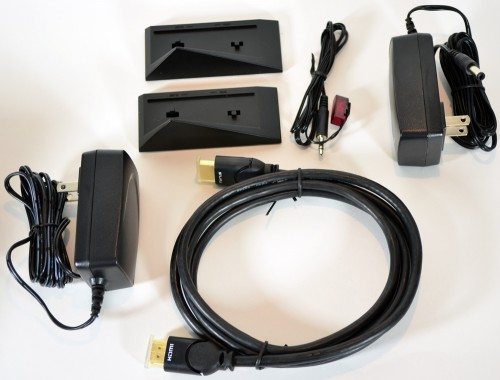


Gadgeteer Comment Policy - Please read before commenting
GREAT SITE!! 1-You said that the [■Transmission distance: 100ft (30m) Line of Sign (LOS)] is 100 feet “Line of Sight”. Is it REALLY line of sight? Does/Must your Receiver in your Bedroom (BR) “See” the Transmitter in your Family Room(FR), or will it go around corners and thru sheetrock walls? 2- If you forget to “switch” to the BR when you were in the FR, can you “change the destination TV” from your bed in the BR, to the BR?
@Bob Chaphe The transmission distance is up to 100 feet when you have unobstructed line of sight. However, it will transmit through walls, ceilings, or floors – but you may not be able to transmit 100 feet with obstructions in the way. In my case, I had my TV in my bedroom and the cable box in the living room. The two Nyrius boxes were about 30-35 feet apart, but they were separated by two walls. Each wall is about 4″ thick and consists of wood, 2 layers of wire mesh, and 2 layers of thick plaster. The picture on my bedroom TV was perfect, even going through all these wires.
There is no destination TV to switch to. You can only transmit to one TV – the one the receiver box is connected to. The boxes are always on and paired, or they are in standby and paired.
My Bad. I didn’t read it correctly. You said “I’ll have to switch the HDMI cable from the living room TV to the Nyrius box, but that can be pretty easily done if I use the HDMI input on the side of my living room TV.” You have to “physically” unplug & re-plug the cable on the Living Room TV…Correct? They should have a “manual” electronic switch (to fool the cable/Sat companies) that control 2 HDMI Out ports (controlled from either box via remote) that switches it from the LR TV to the Transmitter/BR TV. Just a Thought for their Suggestion Box!
@Bob Chaphe Yes, I have to physically move the HDMI cable back to the living room TV to watch in there or move it to the Nyrius transmitter to watch in the bedroom. That’s no big deal to me, and the fact that there isn’t any sort of splitter or switch in the transmitter is why I can successfully use this box with my cable service. I don’t mind switching the cable myself, because I can reach the HDMI connector on the side of my living room TV easily without having to move the cabinet away from the wall.
You can purchase inexpensive three way hdmi splitters for less than $ 40. I’ve used one on my HD DirecTV for several years to run three TV’s off of one receiver/DVR. Also I recently purchased an HDMI switch (for about $15) to use at my Vizio TV when all but on HDMI connection went dead.
You can find both splitters and switches for sale on the Internet.
Thanx Larry!!
I presume you have the “other 2” from your DirecTV going to TVs in your house that are “hard wired” back to the splitter…Correct?? What is the length of those cables & do you have picture degradation??
Bob Chaphe
The output from my DirecTV receiver/DVR goes to my three-way splitter and the three outputs from the 110V powered splitter go to the TV just above the splitter, a TV on the porch, and a TV in the living room. The last two HDMI cables are 33 feet long. I purchased them from Microbarn.com for $25 each. I have had excellent success with this setup. Once every 6 months or so I’ll have a connection problem with the TV on the porch or the one in the living room. I just unplug the cable going into the HDMI splitter fromt the DirecTV box and plug it back in and everything works again. There is absolutely no picture degradation on any of the TV’s.
I just thought of one more thing. I have the DirecTV remote set for RF (radio frequency) so that I can control the DirecTV box from the porch or living room. Also, I should mention that I ran the HDMI cables under the house in the crawl space and terminated them in the baseboard in a connection box I bought at Home Depot. There is a six foot HDMI cable running from the connection on the baseboard to the TV, and in the living room, there is a second six foot HDMI cable running from the HDMI switch I installed on that TV to provide it with multiple HDMI ports.
This sounds like a great product and would make it so that I could save a little money rather than getting another cable box, but I do have a questions. I know that you mentioned that it will go through walls but do they have to be pointing at each other or do you think it would work if the boxes were on different floors? I would be able to have them a lot closer than 100 feet so that wouldn’t be an issue.
@John Ferderer Nyrius says it will go through walls, ceilings, and floors. I think they only mentioned line of sight because that is how you’ll get the longest distance between the boxes. You can have other configurations, but the interference from the walls, ceilings, and floor means that you won’t be able to put the boxes as far apart.
This seems like too much work for me, and just not worth it considering that I can’t have a different channel on each TV. Technology in the pay TV industry is advancing so rapidly, there are tons of options out there to accomplish this. The best being the new Hopper from DISH, which I’ve been able to test as one of their employees, accompanied with its Joeys, you’d be able to do all of this. The Hopper, which will usually be placed at the main TV of the house, will work for that TV, and send programming to the Joeys, which go to secondary TVs, throughout the house. My secondary TV is also wall mounted and, like you, aesthetics is important to me so I didn’t want cords or anything showing. The installer was able to hide the cords, and the Joey is small enough to be mounted behind the wall mount and that too is unseen. It is the same as having my own receiver in the other rooms, they are in high definition and watching TV in one of the rooms did not affect any of my other TVs.
I can’t get the IR Remote extender to work…that is a major problem for me to have to go upstairs to change the channel and sit thru commercials…the video is goo but no signal to my cable box to change stations or FF/REWIND…Help!
I don’t even know if this is available in the UK or not – but wouldn’t constantly changing the HDMI plugs eventually be likely to damage the sockets – occasionally is one thing, a couple of times a day, every day is quite another.
I have freeview on both my TVs but in the lounge I can get HD broadcasts and my recorded content from my Humax PVR – what I would like to do is get these transmitted to my bedroom TV as well (in HD) but not simultaneously broadcast. I can I believe get the recorded content if I have another Humax set top box but that like this is an expensive solution to distribute a service which is free in the first place (I can understand why sky and cable might block) but why a freeview solution?
@gbswales You could buy an HDMI switch box to switch the input between the TV and the Nyrius.
yes I suppose or I could just by a Humax HD tuner for the bedroom as I think it is possible to stream the recordings to a humax tuner from a humx pvr – that would be cheaper too!
Hi Guys. This product sis interesting, I have a Sony hdr camcorder, Is it possible to use this device and stream the video from the camera to my laptop directly while I am recording. i mean like video grabbing.
@Ravi Yes it’s possible